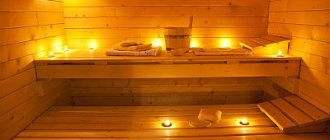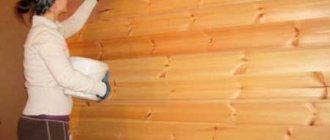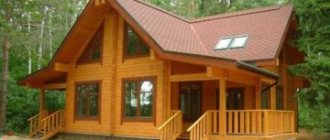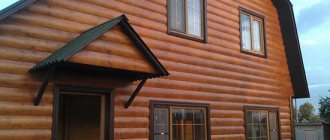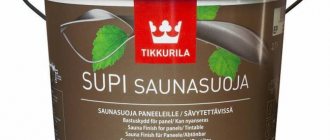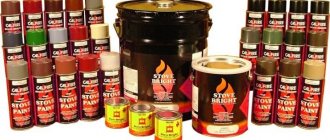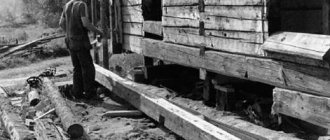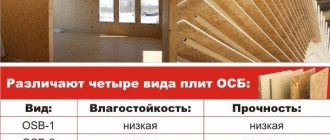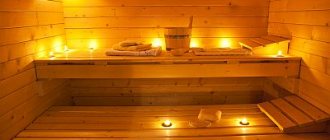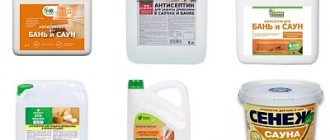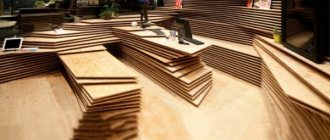Today I’ll tell you how novice builders, when building a wooden house for the first time, probably heard advice regarding the antiseptic treatment of a log house. Some listen and carry it out, while others neglect the use of antiseptics, because... They don’t even suspect what problems can arise in the first year after construction with a wooden house not impregnated with antiseptics.
1 reason for antiseptic treatment of a log house
All untreated wood materials are exposed to biological agents. Mold and fungus spores usually appear on wood in the forest, before it is cut down. And as soon as suitable conditions for the development of biological pests are provided, they will immediately begin to develop. Initially, small multi-colored spots can be detected on the material. Over time, these stains will begin to grow, they will not only worsen the appearance of the wood, but also have a negative impact on the health of people around. Residents of a wooden house infected with mold may develop allergic diseases, problems with the upper respiratory tract, laryngitis is often observed, and asthma is possible.
In the future, these fungi will begin to develop into wood-destroying fungi, which will begin to destroy the wooden material. A tree under their influence can turn into dust in a short period. And then it will be impossible to return it to its previous appearance.
2 reasons for antiseptic treatment of a log house
Wood is a living material, which is why it is valued in the field of house construction. The same quality of wood is also valued by insects that settle in it and feed on its fibers. These beetles are pests that cause great harm to wooden materials. They settle under the bark, as deep as possible, and gnaw through many passages in it, which impair the strength of the material. Over time, the tree can fall apart even from slight mechanical stress.
Insects can also bring a fungal infection deep into the wood. Why will it begin to rot from the inside? The danger is that insect infestation of a material is difficult to detect at first, and in more severe situations it is impossible to restore the characteristics of the material.
3 reasons for antiseptic treatment of a log house
Wooden material is also negatively affected by the environment. Wood can crack and fade from sunlight. Constant rain and contact with moisture can lead to rotting of the wooden material. Fire is a great danger to a log house; under its influence a large house can burn out in just minutes.
All these pests and atmospheric conditions lead to damage to the wooden material, deterioration of its strength characteristics and overall appearance. Antiseptic impregnations can protect a home from many unpleasant influences; they prevent the occurrence of fungi and mold, insects, fire and reduce the severity of the consequences of weather conditions.
What treatment is needed for a log house?
A brand new, newly built log house looks just great, and many owners are not going to use any additional coatings. But wood is a living material, subject to various physical and biological negative factors, so very soon it will begin to turn black, and then rotting processes will begin, which will significantly shorten the life of the house.
Because of this and some other reasons, it is imperative to take care of protecting walls and all wooden structural elements with the help of special coatings. What is the best way to treat a log house?
How to properly treat the outside of a log house
- For the first time, the log house is treated with antiseptics inside and outside immediately after assembly. Pay special attention to processing the ends and logs in contact with the foundation. Antiseptics are applied in two layers;
- Primary treatment should not be carried out at temperatures below 10-12 degrees!;
- The next treatment is done after the log has completely dried and the frame has shrunk. This takes 6-12 months. This finishing involves the final complex and multi-layer processing of the house, which will ensure long-term protection of the log. It is important to apply antiseptics to a dry and clean wood surface!;
- Before processing, the logs are sanded to remove the top layer in which fungus and microbes have accumulated during shrinkage. It will remove defects in the log and level the surface. Sanding wooden walls is a must for an old house, as it is important to completely remove the previous coating;
- Processing with a brush will take a lot of time, but it will be of the highest quality, effective and durable. To speed up the process, spray guns are used. But for processing ends, corners and hard-to-reach places, take only a brush;
- First of all, antiseptic agents are applied in two or three layers. After drying, the wood is treated with fire retardants in one or two layers and also left to dry. The next layer is primer. It will protect the wood from cracks and level the walls;
- Carefully process the ends. These parts of the logs absorb moisture faster than others and are therefore more susceptible to rotting. To avoid this, each end treatment is done in 4-5 layers;
- The final stage is a decorative coating that will preserve the appearance of the house and protect the surface from sunlight. With the help of colored paints and varnishes, a certain color or shade, matte or glossy shine is achieved. If you want to preserve the natural color of the wood, use transparent paints and varnishes.
What should you protect a wooden house from?
Processing of a log house is required for several reasons. Wood is threatened not only by microorganisms, but also by other factors, each of which requires specialized protection. How to treat a log house inside a house?
- Wood needs protection from insects: wood-boring beetles infect all wooden elements, which ultimately leads to a decrease in strength and premature collapse. In addition, wooden structures can be damaged by rodents. House logs and other parts are treated with an antiseptic against all biological threats: this is a special composition that prevents rotting.
- Wood is a flammable material, and this threat cannot be ignored. A faulty heating system or faulty electrical wiring can lead to a fire that ultimately completely destroys the house. To prevent disaster, the building must be carefully treated with fire retardants. These are substances that prevent combustion. With their help you can protect walls and prevent the spread of fire.
- Wood, especially pine, is prone to discoloration, which indicates the beginning of the destruction of the top layer. To protect against putrefactive processes and the negative effects of moisture, the log house can be painted, for which all kinds of water-based varnishes and paints are used. If you do not want to hide the natural texture of the wood, you can use glaze compounds, which, thanks to their translucent composition, will allow you to demonstrate the beauty of the wood.
When choosing how to treat a log house, you need to pay attention to the quality of the purchased building materials. The durability of the entire structure and its security will depend on the reliability of processing, so it is better not to save money here. Russian and Finnish antiseptics and fire retardants are in great demand today; they can be purchased at any hardware store.
How and when to treat at home
The initial treatment of wood with antiseptics is carried out by the manufacturer of the log or timber, as it should protect the material from rotting during storage and delivery to the site. After construction, the log house must be left for six months until the final completion of shrinkage.
How to treat a log house? There are two options:
- Manual. Antiseptics, fire retardants and paints are applied manually using brushes and rollers of various sizes. The advantages are clear: you can process and then paint literally every centimeter of the space, but such work requires a lot of time. You will have to spend more than one day, in addition, it is advisable to have the skill of painting a log, since the paint may lie unevenly.
- Using a spray bottle. A sprayer will speed up processing many times over, but you need to know how to work with it. In any case, the sprayer will not help in processing the joints of logs; difficult areas will still have to be passed over with a brush several times.
In what order are the compounds applied?
If the wood is in good condition, you need to start with fire retardants, then treat it with an antiseptic, and use preservatives before applying the finishing coat. If the tree is damaged by bark beetles or mold, then first a primer with active fungicides (Neomid, Pufas) is applied, then fire retardants (although some prefer to do without them altogether).
If the tree is already infected with insects and there are probably bark beetle larvae in the depths, this scourge must be dealt with radically. It is not enough to simply apply an antiseptic with a brush. Firstly, a separate product is required (Antizhuk, Lignofix concentrates), and secondly, the application methods are different - injecting or intensive spraying.
Of course, we did not include tinting, putty and other products responsible for decorative design in the list. Their use is dictated only by the taste and needs of the home owners.
Important subtleties of home processing
Antiseptic treatment is the most critical stage, as it requires deep impregnation and maximum attention to quality. The composition is applied in several layers, and the treatment is carried out horizontally: first, one log is completely covered with an antiseptic, then the next.
Particular attention should be paid to the first crown, which suffers most seriously from exposure to moisture, and to the ends of the logs. Significantly more protective compounds are always used on the ends; this should be taken into account when purchasing.
Only after the first layer of antiseptic has dried can re-treatment be carried out. This procedure may take two days, but the house will receive the most reliable and durable protection.
The question often arises: will chemical treatment be harmful to the log house? Since it protects it from rotting, this outweighs the possible harm caused by the use of chemical compounds.
Source
The procedure for carrying out wall treatment work
External treatment of a new building begins after the construction and installation of the roof. The desired level of wood moisture is no more than 25% (measured with a contact or non-contact moisture meter). It is carried out in 4 stages.
For a painted house the process is different:
- Surface preparation begins with removing the old paint layer using sandpaper, a spatula, a sander, and special gel products - paint removers;
- The cleaned surface must be dusted with a vacuum cleaner and wiped with a damp cloth;
- Prime with a composition with fungicidal additives in 1-2 layers;
- Carefully move the varnish or paint, add thinner if necessary and apply 2-3 times with an interval of at least 48 hours between coats.
Complete external processing of a wooden house is an incredibly labor-intensive process. This takes a lot of time and money. But you shouldn’t feel sorry and lazy - the service life of the building, its safety and beauty depend on your actions.
Wood is one of the oldest and most stylish building materials besides stone and clay. Throughout the history of construction, man has gained vast experience in handling wood, learned its features, and learned to make it stronger and more durable with the help of protective equipment. The main one of these points is the use of impregnation for wood and its elements.
Why do you need to process?
A log house is a choice in favor of environmental friendliness, taking care of your health and your loved ones. Treatment of the walls of wooden houses is necessary not only as protection, but also to extend the service life of the material and stability .
When it comes to the reliability of construction materials, each material, including logs and other types of wood, is considered based on all possible factors affecting it.
These are the following factors:
These and other factors force owners of wooden houses to take protective measures before such problems arise. To summarize on all points, the processing provides the following:
- Protection of logs from destruction.
- It is also important for the log to maintain its fresh appearance for as long as possible. This effect can only be achieved through timely processing.
- The treatment prevents the attack of fungi and other wood rot.
- Protects against moisture.
- Protects against insects.
- Extends the service life of the building.
- Improves the aesthetic characteristics of the building.
- Increases resistance to fire.
Useful tips
Some useful tips for those who are starting home renovations:
- You shouldn’t skimp too much on paint or varnish, because poor-quality interior finishing is immediately noticeable;
- for interior decoration, it is more convenient to use color scheme, you can get the most unimaginable colors and shades;
- do not forget that the next layer is applied only after the previous one has completely dried;
- Do not forget about protective equipment, gloves and a respirator, as well as open windows or regular ventilation will eliminate many problems.
With the help of color, the question of how to paint the wooden walls inside the house will depend only on your imagination. Source tr.decoratex.biz
Of course, construction and renovation is a complex task that takes a lot of time and effort, but how nice it is to enter a beautiful new home with your household members . This also applies to painting the interior walls of a wooden house according to a design project or according to your own idea. But when your own home is completely ready to accept its owners, then it’s time to set new goals, the achievement of which will certainly be even more exciting.
Types of materials
Materials for protecting logs are divided into the following types according to functionality:
- Whitening.
- Fire retardant.
- Antiseptic.
Let's look at each of the options in more detail.
Bleaching agents
The most popular means for bleaching logs are as follows:
- Holzentgrauer is a universal water-based impregnation. The manufacturer is the well-known DUFA brand, distinguished by excellent product quality. The brand offers a wide range of colors for the treatment fluid. Holzentgrauer not only protects the wood, but also helps restore the original physical properties of the material.
By applying this product, you can forget about such problems as black or blue logs, cracks, dampness, fungi, mold, insect larvae or fire. The product is very easy to work with. It belongs to the safe types of chemical compounds. Price – about 200 rubles. for 1 kg.
SAGUS .
It is used for a wide range of sawn and planed materials, and is also capable of protecting even concrete, tiles, stone or brick. The product is suitable for both external and internal use.
The drug actively protects the log from fungal infections and darkening of the surface. It also removes existing larvae of harmful biological microorganisms.
When working with SAGUS, it is necessary to monitor the ambient temperature - it should be at least +5 degrees. Before applying the composition, the surface of the wood should be sanded properly, the log houses should be dried and cleaned of dust.
Repeated application is permissible no earlier than 40 minutes. Complete drying will take about 24 hours if the humidity does not exceed 60%. From a technical point of view, SAGUS is a low-hazard composition for humans. Average price – 800 rub. for 10 l. NEOMID 500 is a popular whitening and cleansing composition. It is effective against the larvae of destructive fungi. If the log already has the first signs of damage, then NEOMID 500 stops this process and restores the original properties of the wood. It is often used to process pallets on which food products are transported and stored.
When working with NEOMID 500, it is important to ensure that the product does not get on the galvanized fasteners of the structure. It is permissible to use a glass or plastic container to dose the product. The product is applied diluted with water in a ratio of 1:1 - for the protective layer and 1:2 - in the presence of visible damage and darkening. Price – 3800 rub. for 24 kg. League Bioshield is a radical product based on chlorine bleach. It is also considered a medicinal agent. Its action is also effective against the most insidious “enemy” of wood – the porcini mushroom.
Even if there are old foci of fungal infection, treatment with League Bioshield in 2 layers will return the log to its original characteristics.
Bioshield can be effectively applied manually using a paint brush. With this method, the product is absorbed as much as possible by the log. From 600 rub. for 10 liters.
Fire retardants
Fire retardants should be applied to wooden structures as a priority. The market offers many options; let’s look at some brands in more detail:
PHENYLAX is a fire-bioprotective agent used for many types of materials. It is used before applying a moisture-proof coating.
Tools needed for painting
In addition to paint, workers will need the following tools:
- rubber gloves, possibly respirators and hats;
- brushes, rollers, paint trays;
- masking tape to avoid staining surfaces that will not be painted;
- sprayer, with its help painting is carried out much faster;
- a wet rag and a bucket of water to immediately clean up any spills.
There may be several brushes; if you use oil paint or alkyd enamel, stock up on solvent; you won’t be able to remove drops from these paints with water.
Preparing the surface for painting
Painting the walls in the house, the stages that precede it and, most importantly, painting, must be done with high quality.
Before painting, the surface is cleaned of old paint, dust, and greasy contaminants. The washed surface is left to dry. The cracks are sealed using acrylic sealant. This will protect against temperature changes and keep you warm.
Alignment
To obtain a smooth matte surface, the wood is processed using sandpaper or a grinder. Sanding allows you to smooth out irregularities, get rid of knots, and make small cracks invisible.
On even, smooth walls the painting material will lie more evenly Source mybesedka.ru
Painting technology
Before painting, the surface is treated with a primer. This will make the painting process easier and save paint. Applying one coat of paint is usually not enough. The second and subsequent layers are applied after the first has completely dried. The paint must be thoroughly mixed before application. First, use a brush to paint joints, corners, and places where it is impossible to reach with a roller. Then, the main area is painted with a roller. High-quality painting is done in 2-3 layers.
Video about painting a house:
Works outside and inside the building
Processing can be carried out both after completion of construction and during the process. The measures used during the construction process are called structural timber protection methods.
Wall ends
The ends of the log require a separate approach, since this part is very vulnerable to moisture. To protect against the effects of moisture, the log should be treated with a water-repellent compound.
It is important to intensively treat the ends of the lower logs, since they need to be protected not only from moisture in the atmosphere, but also from the ground. Therefore, the lower part is processed on average in 5 layers, and the upper elements need 2-3 layers of processing.
End processing is carried out in one of the following ways:
- If an aqueous solution, then use a spray bottle.
- You can use a regular brush.
- Logs are often impregnated by immersion. But of course, this must be taken care of before construction begins.
Thick mixtures are applied using a roller.
What rules must be followed?
It is recommended to sand it properly before processing.
How to apply impregnation
Depending on the type of compounds used for the log house, the method of applying them may differ. There are several methods of applying impregnation:
- Use of rollers and brushes. This method is more time-consuming and is suitable for applying thick, viscous mixtures.
- Use of spray guns. This method is considered high quality and less expensive.
- Sprayers are suitable for applying only aqueous solutions. The procedure is carried out using special equipment - glasses, a respirator and gloves.
- A method of immersing logs in baths with prophylactic compounds. This approach allows for deeper and higher-quality impregnation of the structure in hard-to-reach places.
- Method of diffuse (dry) impregnation. Suitable for cases where an antiseptic and fire retardant are used in the form of a paste or powder.
If all rules for processing logs are observed, subsequent activities are carried out after 3–4 years. Many high-quality drugs retain their unique properties for 6 years.
Step-by-step instruction
Processing a log frame consists of several simple steps. The order is as follows:
- Surface grinding.
- Application of bleach.
- Application of antiseptic.
- Fire retardant layer.
Reapplication is carried out after the first layer has dried completely . SAGUS, for example, can be reapplied 40 minutes after the first application. But the drying time varies for different products. Information about this is usually indicated on the packaging or in separate instructions.
Work technology
Preparatory work
If you decide to paint or varnish wooden wall cladding, then the instructions given in this section will help you understand the nuances of the technology.
Work must begin with surface preparation:
- If the boards were previously painted or varnished, then the old coating must be removed. We soften the painted layer with warm water or a stream of hot air from a hair dryer, and then remove it with a spatula.
- We remove the remaining paint and varnish using a sanding machine.
- If we process new wood, then it needs to be sanded all the more. To do this, we successively use several abrasive materials, gradually reducing the grain size - this way we get a perfectly flat surface.
Advice! If there are defects on the sheathing, then before sanding they must be masked by using a small amount of wood putty. After waiting for the putty to dry, we clean the area with sandpaper, and then sand the surface.
- Afterwards, it makes sense to treat all surfaces with a penetrating water-based antiseptic primer.
- Apply the primer in one or two layers, making sure that the wood does not get too wet.
- After the primed surface has dried, the lining inside the house can be painted or varnished.
Application of the composition
Both painting and varnishing can be done with your own hands.
The process itself is not complicated, but there are still a few recommendations that are worth listening to:
- Having decided how to treat the wood inside the house, it is worth purchasing the selected composition with a small margin. The thing is that the shade of paint or tinted varnish may differ in different batches, so it is better to paint everything with one material.
- Before starting work, mix both paint and varnish thoroughly. This is done in order to compensate for the delamination of components that occurred during storage.
- To apply the composition, use a wide flat brush. We will also need a narrow brush on a long curved handle - we will use it to penetrate hard-to-reach places.
- We apply both paint and varnish in several layers. The more layers and the smaller their thickness, the better the result.
- The direction of the strokes should be perpendicular. So, for example, we apply even layers vertically, odd ones horizontally, or vice versa.
- After applying each layer, you need to dry the surface. Drying time depends on the type of composition used, so you need to plan the work individually.
And most importantly, during drying, the fresh layer of finishing should be protected from exposure to drafts and temperature changes, otherwise the coating will quickly begin to crack and peel off.
What can destroy the integrity of the structure?
If classified by type of origin, destructive factors can be divided into the following categories:
- Technogenic factors.
- Natural phenomena.
- Anthropogenic factors.
These factors in practice are expressed as follows:
- Swelling of logs due to increased precipitation and atmospheric humidity. In such an environment, mold appears, fungi and other harmful microorganisms appear.
As humidity decreases, the log dries out and loses its original qualities. This leads to cracking of surfaces. If this process is not stopped in a timely manner, it can cause structural destruction.
Given such circumstances, log walls should be treated as early as possible.
According to their purpose, impregnation is usually divided into the following groups:
- Fire retardants. The main purpose of this group of impregnations is to protect wood from fire or other combustion processes. Such impregnations contain certain components, the melting of which begins with increasing temperature, thereby creating a durable film on the surface of the wood. Its essence is to block the access of oxygen to the tree, and without oxygen, as we all know, there will be no fire. Fire-prevention impregnation for wood must be used during the construction and repair of log houses, as the main guarantee of subsequent safety;
- Antiseptics. Antiseptic impregnations protect wood from decomposition and rotting, as well as other types of biological damage. This impregnation contains biocides (special potent poisons), they effectively destroy any pathogenic microorganisms and small insects, preventing them from multiplying and multiplying and at the same time destroying the wood from the inside.
The most common antiseptic impregnations: Aquatex, Kram, Biosept, Tikkurila, Vintol, Biotonex, Senezh;
- Anti-atmospheric. Such impregnations serve to protect wood from various negative environmental influences and precipitation. All compositions of this impregnation protect the structure of the wood from the formation of various cracks, drying out and other deformations. One of the significant disadvantages of such impregnations is that after their treatment, the wood loses its external aesthetic appearance and deteriorates its certain characteristics. When protecting wood from moisture and water, the best option would be complete impregnation - i.e. immersion in the bath.
- Water-repellent special impregnation for wood is a solution that increases the strength of the entire material and its high resistance to water; wax is more often used. These compositions significantly extend the life of wood buildings. This impregnation for wood against moisture and rot is ideal for you. More common and popular in the Russian construction market are solutions such as Tikkurila.
Quite often, water-repellent impregnations for wood contain oxides of certain metals, which protect the material from the destructive effects of ultraviolet radiation, as well as fading and drying out. But the oxides will also give the impregnation a certain color. Depending on the metal used, the color varies from light yellow to burgundy, or blue and violet. Therefore, you can not only protect the wood, but also give it an original and beautiful appearance;
- Combined. Combined impregnations are compositions that protect wood from various factors, for example, from fire and various bacteria, from water and the formation of harmful fungi. In places where humidity is high and the risk of wood contamination is very high, such impregnation is very useful.
Impregnation selection criteria
In order to choose a specific protective solution, consider some nuances. For example, if you choose a water-based impregnation, then you will need additional drying of the wood, which will lead to its deformation.
Use antiseptic impregnations, which are water-based, to treat the linings under the purlins and the purlins themselves; you can also paint partition panels, joists and beams, beams. In this way, you can process elementary lightweight structures that will not deform or bend, and which will not cause much harm or damage.
Oily compounds and oils for wood impregnation have an unpleasant, persistent odor that is quite difficult to erode, and therefore it is better not to use these wood impregnations for internal processing of wooden structures. In addition, all oil solutions ignite very quickly, releasing toxins into the air. Once you have treated the wood with oil, it will become impossible to work, paint or process. Therefore, oil impregnations are only suitable for wooden parts and elements that are located outdoors and are regularly in contact with water.
You should choose an antiseptic impregnation for wood taking into account the specific type of wood, since different types have varying degrees of resistance to various biological destroyers:
- “weak” wood is aspen, linden, alder;
- low-resistant wood - oak, birch and beech sapwood, elm heartwood and maple;
- medium-resistant wood - fir, spruce, larch, cedar sapwood;
- rot-resistant wood - ash, pine, oak heartwood and larch.
Different types of wood absorb certain protective compounds differently, and this should be taken into account when making the final choice of impregnation. Three main groups of wood can be distinguished based on the difficulty of absorbing impregnation:
- difficult - spruce, ash, oak and beech;
- medium - linden, pine core, alder, aspen, maple sapwood;
- light - beech, pine sapwood and birch.
The nuances of do-it-yourself impregnation at home
The price of wood impregnation will depend on its purpose and composition, but you can save a lot and prepare a simple protective impregnation for. In this case, impregnation will be much cheaper than a budget purchase option.
The basis for do-it-yourself impregnation is bitumen.
Impregnation preparation process:
- Pour bitumen into an unused old metal bucket or container.
- Place the bucket on the fire and bring the bitumen to a boil.
- Remove the bucket from the heat and, while stirring, pour in diesel fuel in a thin stream so that the mixture does not have time to thicken even after it has cooled.
In order to prepare a quick-drying impregnation, dilute the bitumen not with diesel fuel, but with gasoline. But in this case, do not heat the composition - the bitumen should completely dissolve in gasoline. After treating wood with this solution, it can be safely painted, coated with various enamels and primed. But under no circumstances use nitro varnishes and paints!
Precautionary measures
Impregnation for a wooden house outside and inside, fire retardant and antiseptic, contain dangerous chemical additives and substances that can... That is why during the processing process, remember your safety measures, and strictly follow the instructions from the manufacturer. Before you buy impregnation, carefully study the information about the degree of toxicity of the composition and its possible use and application inside the house.
Impregnation for wood is a necessary and important protective measure in modern repairs and construction.
. Regardless of the hazardous chemicals contained in the impregnation, it can significantly increase the service life of all buildings and ensure safety from fires and various atmospheric phenomena. Good luck!
A wooden house is an environmentally friendly and safe housing that will never lose popularity. Natural wood does not emit toxic hazardous substances, has a pleasant forest aroma and promotes rapid oxygen exchange. In such a house there is always fresh air, a comfortable environment and a cozy atmosphere.
The logs are easy to lay, which reduces installation time. Due to their light weight, they do not require a deep, expensive foundation. And thanks to the natural beauty and aesthetics of the materials, serious and expensive finishing is not required.
However, wooden houses also have a significant disadvantage. Wood is a natural material that is subject to negative environmental influences. Sun rays, moisture and precipitation, insects lead to the fact that the material gradually darkens and collapses. Mold, cracks and fungus appear, and the structure loses its original appearance. To avoid these problems, it is necessary to treat the log house inside and outside using various means.
How much will all this cost?
To calculate the cost, it is necessary to consider all types of work carried out to process a log house. Typically, the processing procedure includes the following types of work:
- Engineer consultation.
- Dismantling works.
- Processing procedures.
- Installation work.
Now let's look at the average prices. You can take Moscow price tags as a guide. So:
- Consultation with an engineer – 1900-2500 rubles.
- Dismantling of various structural parts - from 130 rubles per 1 m 2.
- Applying antiseptic to a log - from 50 rubles per 1 m2.
- Coating with fire-fighting compounds - from 55 rubles per 1 m 2.
- Treatment against mold, fungi, etc. – from 50 rubles per 1 m2.
- Installation of wooden structure parts - from 150 rubles per 1 m2.
Top best products for external wood treatment
| Brand | Characteristic | Price |
| Senezh (Russia) | High-class, difficult-to-wash compounds in 20 types, including whitening and renewing compounds, antiseptics for baths, homes and gazebos; protect from fire, pests and moisture, provides protection for more than 10 years! | from 380 rubles (5kg) |
| Belinka (Slovenia) | Natural and safe, highly effective products that protect against ultraviolet radiation, moisture, insects and fire, a wide range of products | from 400 rubles (1l) |
| Pinotex (Estonia) | Polymer-based products protect against mold and moisture, fungus and insects, and withstand sudden temperature changes, therefore they are optimal for external treatment | from 280 rubles (1 l) |
| Neomid (Russia) | Effective impregnation for home, bathhouses and wooden floors, protects the surface from moisture for 5-7 years, they produce special products for treating the ends, a good price-quality ratio | from 200 rubles (1 l) |
| Tikkurila (Finland) | Moisture-resistant products, create a thin protective film and provide reliable protection from precipitation, are distinguished by high quality and positive reviews | from 250 rubles (1l) |
| Aquatex (Russia) | Available in the form of a primer and impregnation, colorless and tinted versions (15 colors), protects against fungus, ultraviolet radiation and moisture, suitable for middle-class wood | from 200 rubles (1 l) |
| Sitex (Russia) | Suitable for any type of wood, protects logs from moisture, preserves the appearance of the structure for 10 years, colorless and tinted options (12 colors) | from 200 rubles (1 l) |
